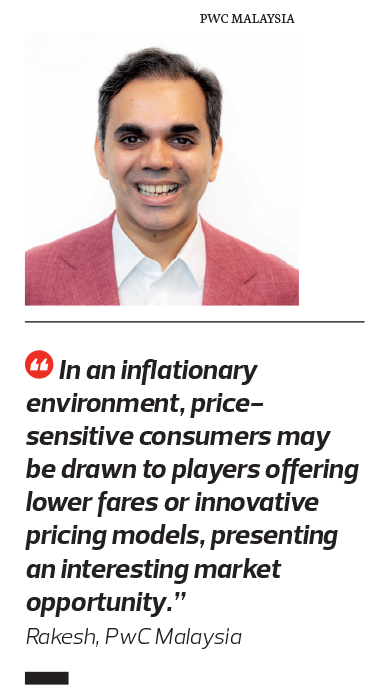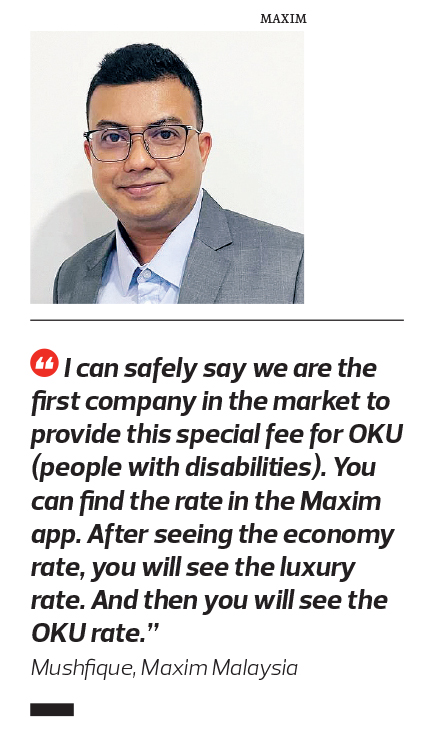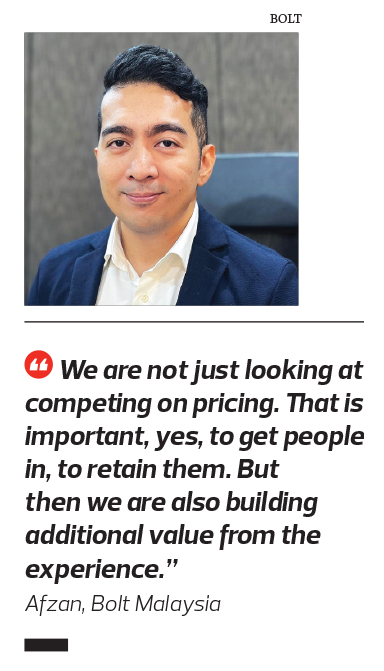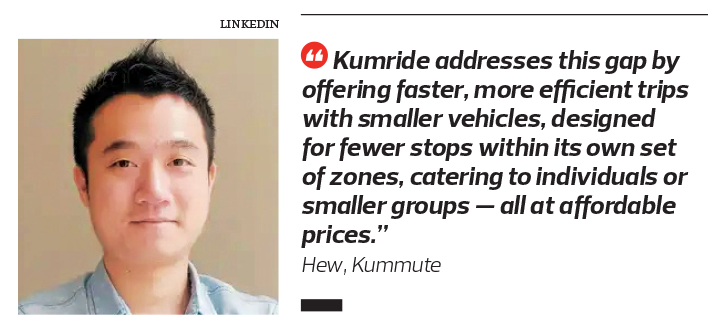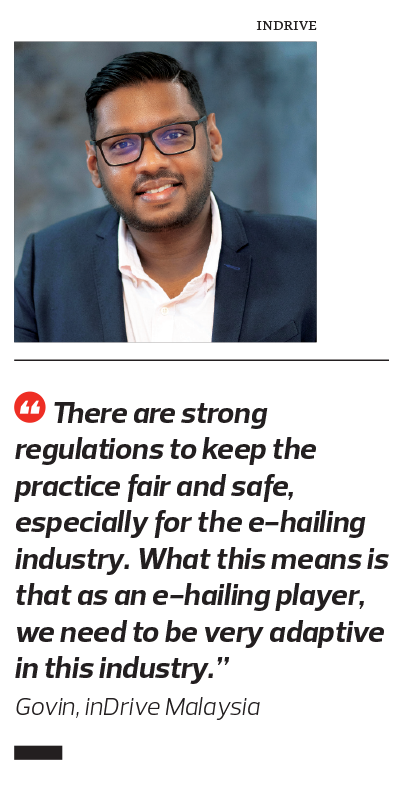
This article first appeared in Digital Edge, The Edge Malaysia Weekly on December 9, 2024 - December 15, 2024
The phrase “take a Grab” has become ubiquitous in most major cities in Malaysia and much of the region, reflecting the company’s dominance in the e-hailing space. Since it acquired Uber’s Southeast Asia operations six years ago, Grab Holdings Inc has enjoyed the biggest market share, solidifying its role as the go-to option for urban mobility.
But that dominance is now facing fresh challenges. A wave of new competitors, both local and foreign, have set their sights on the Malaysian market, eager to change how city dwellers move about. The entrants are not just chipping away at Grab’s market share, they are also promising to rewrite the rules of the e-hailing landscape and transform the way urban commuters go about their journeys.
The question now is whether these start-ups can overcome the juggernaut’s deeply entrenched presence — or if they are destined to meet the same fate as Uber.
According to Grab’s 2023 annual report, it was a good year for the company with a net income of US$60 million, a significant jump from its heavy losses in 2022 and 2021.
Malaysia remains Grab’s largest market, delivering a revenue of US$673 million in 2023 — a 32% rise from the previous year. Across Southeast Asia, its mobility division generated US$869 million in revenue.
Grab’s second quarter of 2024 report highlighted a significant milestone, that it serves 41 million monthly transacting users, cementing its foothold in the region. The report also revealed a provision in its legal department accounts related to the Malaysia Competition Commission (MyCC).
In 2019, MyCC fined Grab RM86.8 million, for a breach of anti-competition laws following its acquisition of Uber’s regional business. However, the decision to impose a financial penalty was overturned at the High Court in July last year, with Grab arguing that the acquisition was standard business practice. MyCC is appealing the ruling and the Court of Appeal is set to hear the case on Feb 28 next year. The annual report said the legal claim was unlikely to impact the company’s financial position beyond the provision recorded as at Dec 31, 2023.
These figures solidify Grab’s influence in the market, and emerging players are seemingly walking into an uphill battle.
“The challenges will come in competing with strong brand loyalty and the ecosystem of established players that offer integrated services like food and grocery delivery and mobile wallet. It may be harder to win and retain users without a holistic ecosystem,” says Rakesh Mani, consumer markets leader at PwC Malaysia.
Grab has spent years building a strong connection with locals and establishing itself as a reliable choice, creating a foundation that many instinctively turn to. However, this does not guarantee that the road ahead will remain free of challenges.
One of the main issues is the rising fare rates, particularly after Grab announced in January last year that these would increase during peak hours. The fare per minute was raised to 43 sen from 20 sen, while the fare per kilometre was reduced to 25 sen from 70 sen. Grab declined to be interviewed for this article.
Striking a balance between satisfying the drivers and passengers remains a challenge as no clear benchmark has been established to regulate fares. The complexity of e-hailing fare regulation stems from a web of interconnected variables, including traffic, distance, time and other factors.
Recognising this, new players have seized the opportunity to challenge the status quo. They aim to redefine and democratise the e-hailing market.
“In an inflationary environment, price-sensitive consumers may be drawn to players offering lower fares or innovative pricing models, presenting an interesting market opportunity,” says Rakesh.
Malaysia is already considered a significant e-hailing market, he adds. Congestion in cities has spurred demand for mobility and other supporting factors such as the widespread use of digital payment systems and strong tourism market have driven operators even further to reap the benefits of joining the competitive e-hailing landscape.
Even with this vigour, however, emerging e-hailing players must trudge an extra mile to win market share, and this includes providing other services and functionalities, such as food and parcel delivery as well as digital banking.
Grab’s success and longevity can be largely attributed to its superapp strategy, due to its integration into Malaysian society. This means new players must find other ways to stand out in the market.
“New players could face a very competitive situation with the dominance of large ‘super apps’, but they might be able to carve out specific niches,” says Rakesh.
Indonesia-based Gojek, a cut-throat competitor to Grab in the country, has adapted and deployed similar strategies, which is why it is a leading e-hailing player.
Vying for the e-hailing throne
inDrive, an e-hailing company founded in Siberia, came to Malaysia in 2021 and presented a system that did not previously exist in the country — peer-to-peer pricing for ride bookings.
During a booking, a recommended fare is displayed. The user then sets a price for what he or she thinks it is worth. Drivers either accept the price or negotiate with the user.
So, instead of charging a standard fare, inDrive’s system allows riders and drivers to be strategic. This creates a bustling scene where the charge is finalised by mutual agreement between the rider and driver.
The bidding system has become a staple feature in its e-hailing services in 46 countries, and inDrive believes its unique proposition provides it with a competitive edge in the industry.
“Instead of depending on algorithm-based pricing, which causes high fares at certain times of the day, [peer-to-peer pricing] has led to higher satisfaction rates. That is something which inDrive has done in other countries before coming into Malaysia, and that is its main unique proposition,” says Govin Kumaar Panirsheeluam, business development lead at inDrive Malaysia.
This model can respond instantly to real-time changes in demand and supply, unlike automated algorithms, which often require time to adapt to evolving market conditions, he points out.
While the price can be negotiated using inDrive’s bidding system, there is still a cap in that it does not exceed twice the recommended price as the highest charge that a rider can offer and the driver to accept.
The ability for passengers and drivers to negotiate is a valuable approach in the Malaysian market as it allows flexibility amid fluctuations in the cost of living, traffic conditions and fuel prices, which can stabilise price surges that tend to rise aggressively during peak hours, says Govin.
inDrive offers a low commission rate of 10% to its driver partners and to address growing demands from passengers, which is a factor that directly increases the total bookings and rides.
“In terms of rides, we are seeing at least a 20% increase. In terms of active users, we are seeing a 21% surge in key cities. This proves there is still a market out there for us,” he says, on the figures for the first half of 2024.
Other e-hailing companies may not have a feature like a bidding system, but they are challenging the space in their own way. Maxim Malaysia, another ride hailing firm, made their launch in the country to provide passengers a user-friendly platform with its accessibility features.
Mushfique Ahmed, head of legal and compliance at Maxim Malaysia, says the company has introduced a special rate for disabled passengers and this option provides friendly drivers with cars that can accommodate various needs, such as space for wheelchairs.
“I can safely say we are the first company in the market to provide this special fee for OKU (people with disabilities). You can find [the rate] in the Maxim app. [After seeing the] economy rate, you will see the luxury rate. And then you will see the OKU rate,” he adds.
Mushfique says voice and speech recognition for users are available as well. The company is currently trying to design a blind-friendly interface.
Another aspect of accessibility is the areas in which it operates. He says the company’s services are not just limited to major cities but include rural towns in Sabah and Sarawak, and even Labuan.
To keep prices affordable for every single user, Maxim conducts an internal competitor analysis to keep charges fair by monitoring its competitors’ performance and making comparisons on rides of the same distance and in the same location.
“We see what is affordable for a user at a point of time. Let’s say at 12pm, we have a driver rating of five stars, but other companies’ prices are a bit higher. Then we’ll try to do an analysis, and that price comparison, and that’s how we set our pricing,” says Mushfique.
On the driver’s side of things, Maxim’s tactic for setting commission rates is a little different. Instead of setting a fixed commission rate, there is a range set at more or less around 10% and it differs from driver to driver. Depending on the company’s assessment, it will assign a suitable rate for the driver.
“There are certain factors and conditions to determine the commission [rate], and each driver has his or her own factors. For example, if I’m a driver partner and I have Maxim branding on my car, I have a [higher commission rate],” Mushfique explains.
He says a lower commission rate can be given to drivers who are forced to accept low fares, which can help the driver with his earnings and also enable low prices for passengers.
The newest e-hailing player in Malaysia is Bolt, an Estonian-based e-hailing player, which made the news as a fresh challenger in the market when it launched. The company abides by a driver-first operating formula, that is, a happy driver equals a happy passenger.
“It’s about how we make sure that we have an engaged driver base. We take care of [our drivers], and they take care of our passengers,” says Afzan Lutfi, general manager at Bolt Malaysia.
“We are not just looking at competing on pricing. That is important, yes, to get people in, to retain them. But then we are also building additional value from the experience.”
Bolt’s commitment to the driver-first principle is evident, as its inaugural Driver Engagement Event was launched recently to celebrate the achievements of its driver partner community.
An example of how Bolt has implemented its driver-first features into its app is its pickup radius feature, where drivers can set a distance of how far they are willing to travel for their passengers. Afzan says this feature empowers drivers with more agency and gives them more control.
Bolt also runs targeted campaigns to increase its drivers’ earnings such as offering ringgit bonuses for every ride to incentivise them. This in turn helps keep fares affordable for passengers.
Bolt wants to foster a supportive environment. Afzan says he and his team have invested time to go to the ground and join drivers in onboarding events to listen to and understand their frustrations and feedback.
He says he has personally onboarded driver partners and keeps in touch with some of them through his direct WhatsApp for feedback. When he receives complaints, the team will take the feedback and make tweaks to the system in real time.
“A complaint is a gift. We’re happy for them to speak with us, to tell us what they like, what they don’t like, what we can do better. Then we can do something about it,” says Afzan.
After gathering the drivers’ comments, Bolt capped its commission rate at 15% during launch and will exercise transparency with its driver partners, he says.
“We give full visibility to our drivers so that they know exactly how much we’re taking and how much they’re earning. If they use our app, they can see their net earnings [instead of a] gross amount that will be subtracted by something they don’t know,” he adds.
Leveraging experience, trust and market insights
It is not just Western players stirring up the e-hailing market. Hong Kong-based Lalamove, best known for its delivery and logistics solutions, has expanded into e-hailing, adding to its portfolio of services.
Amid rising competition, Lalamove adopts a multifaceted strategy. Alongside offering competitive pricing to deliver lower fares, it also focuses on enhancing the user experience, aiming to provide greater convenience and accessibility for both passengers and drivers.
As an established Asian player, Lalamove leverages its market presence, trusted brand reputation and deep expertise to distinguish itself from other entrants to the market.
While its Western competitors often rely on operational models tested in other countries as a foundation, Lalamove’s long-standing presence in Malaysia gives it a distinct edge. Years of operating in the country have enabled it to develop a nuanced understanding of market dynamics and customer behaviour.
Moreover, its experience in the transport sector has allowed it to build strong community relationships and navigate the intricacies of Malaysia’s landscape with ease.
“By combining our deep local insights with a robust, verified driver network, we offer transparent pricing, flexible earning opportunities and localised service solutions that cater specifically to Malaysian market nuances,” says a Lalamove spokesman.
Despite the strong presence of other players, Lalamove’s existing delivery network and technology infrastructure have opened opportunities for it to enter the e-hailing sector by innovating a system that combines the two services. The result of this combination has created a dual-service strategy that stems from its familiarity with facilitating logistics, which has provided the company unique insights into optimising both passenger and delivery services.
The dual-service strategy will serve as an expansion of its driver partners’ earning potential by giving them the flexibility to choose between taking up a ride hailing or delivery service at any time of the day. This also helps the company in developing a comprehensive transport and delivery ecosystem.
Furthermore, Lalamove’s local team seeks to receive feedback that contains nuanced local demands and cultural contexts, enabling the company to provide tailored solutions that directly address community needs.
“Our goal is to remain a trusted and adaptable partner for both users and driver partners by staying deeply connected to the local market dynamics and continuously evolving our services to meet specific regional requirements,” says its spokesman.
Save by subscribing to us for your print and/or digital copy.
P/S: The Edge is also available on Apple's App Store and Android's Google Play.
- FBM KLCI down 4.17% to more than two-year low on global trade war woes
- Asian stock benchmarks drop most in 14 years on tariff concerns
- China has already trade-war-proofed its economy
- Trump team rejects market fears, shows defiance on tariffs
- Malaysia should not panic, rush into decisions over US tariffs, says Amir Hamzah
- Asian stock benchmarks drop most in 14 years on tariff concerns
- Yen, Swiss franc jump in volatile trade as global recession fears grow
- Anwar: Tackle issues effectively to avoid exploitation by irresponsible parties
- Alternative Views: After tariff tantrum, watch out for currency wars
- Short selling in five counters suspended amid market rout

